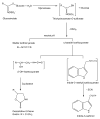Cruciferous vegetables and human cancer risk: epidemiologic evidence and mechanistic basis
- PMID: 17317210
- PMCID: PMC2737735
- DOI: 10.1016/j.phrs.2007.01.009
Cruciferous vegetables and human cancer risk: epidemiologic evidence and mechanistic basis
Abstract
Cruciferous vegetables are a rich source of glucosinolates and their hydrolysis products, including indoles and isothiocyanates, and high intake of cruciferous vegetables has been associated with lower risk of lung and colorectal cancer in some epidemiological studies. Glucosinolate hydrolysis products alter the metabolism or activity of sex hormones in ways that could inhibit the development of hormone-sensitive cancers, but evidence of an inverse association between cruciferous vegetable intake and breast or prostate cancer in humans is limited and inconsistent. Organizations such as the National Cancer Institute recommend the consumption of five to nine servings of fruits and vegetables daily, but separate recommendations for cruciferous vegetables have not been established. Isothiocyanates and indoles derived from the hydrolysis of glucosinolates, such as sulforaphane and indole-3-carbinol (I3C), have been implicated in a variety of anticarcinogenic mechanisms, but deleterious effects also have been reported in some experimental protocols, including tumor promotion over prolonged periods of exposure. Epidemiological studies indicate that human exposure to isothiocyanates and indoles through cruciferous vegetable consumption may decrease cancer risk, but the protective effects may be influenced by individual genetic variation (polymorphisms) in the metabolism and elimination of isothiocyanates from the body. Cooking procedures also affect the bioavailability and intake of glucosinolates and their derivatives. Supplementation with I3C or the related dimer 3,3'-diindolylmethane (DIM) alters urinary estrogen metabolite profiles in women, but the effects of I3C and DIM on breast cancer risk are not known. Small preliminary trials in humans suggest that I3C supplementation may be beneficial in treating conditions related to human papilloma virus infection, such as cervical intraepithelial neoplasia and recurrent respiratory papillomatosis, but larger randomized controlled trials are needed.
Figures



References
-
- Kristal AR, Lampe JW. Brassica vegetables and prostate cancer risk: a review of the epidemiological evidence. Nutr Cancer. 2002;42:1–9. - PubMed
-
- Drewnowski A, Gomez-Carneros C. Bitter taste, phytonutrients, and the consumer: a review. Am J Clin Nutr. 2000;72:1424–35. - PubMed
-
- Holst B, Williamson G. A critical review of the bioavailability of glucosinolates and related compounds. Nat Prod Rep. 2004;21:425–47. - PubMed
-
- Zhang Y. Cancer-preventive isothiocyanates: measurement of human exposure and mechanism of action. Mutat Res. 2004;555:173–90. - PubMed
-
- Liu RH. Potential synergy of phytochemicals in cancer prevention: mechanism of action. J Nutr. 2004;134:3479S–85S. - PubMed
Publication types
MeSH terms
Substances
Grants and funding
LinkOut - more resources
Full Text Sources
Other Literature Sources
Medical

